Nomenclature
Family: Solanaceae
Genus: Solanum
Species: Solanum diphyllum L.
Synonyms: None found
Common Names: Two-leaf nightshade; twin-leaf nightshade; amatillo
Two-leaf nightshade, Solanum diphyllum, is a member of the Solanaceae or potato family. The common garden tomatoes, peppers, and eggplants also belong to the Solanaceae family. The genus Solanum is associated with plants known as nightshades.
Distribution
Two-leaf nightshade is native to the drier lowland areas of Mexico to Pacific Costa Rica. In the 1960s, it was grown in Florida as an ornamental shrub for its tiny white-purple flowers and bright orange fruits. It has escaped cultivation in the subtropics and tropics, including Florida, Texas, Java, and the West Indies. In Florida's eastern counties, it grows as far north as Duval County and from Volusia County south to Miami-Dade County. On the west coast, it is present from Pasco to Lee Counties and in many counties of central Florida.
Ecological Significance
Two-leaf nightshade is a "bird-dispersed" volunteer occurring in urban and conservation areas and on disturbed land. It is seen in hardwood hammocks, maritime hammocks and rockland hammocks, pine flatlands, floodplain forests, and swampy areas. The UF/IFAS Assessment of Non-native Plants in Florida's Natural Areas advises "Caution" and to prevent its escape from cultivation when growing this plant anywhere in the state. In 2017, the Florida Exotic Pest Plant Council listed it as a Category II invasive plant, meaning that its presence in Florida's natural areas has so far not altered these plant communities. Two-leaf nightshade will tolerate temperatures down to 30°F, Zone 9A, and may freeze back in winter but will resprout from its roots. Research shows that 75%–85% of the seeds will germinate, and the seed can stay alive even when buried an inch in the soil for up to two years.
Habit
Two-leaf nightshade is an easily recognizable, small, herbaceous to woody unarmed perennial shrub or small tree, typically 3 to 6 feet tall. It grows as a weed in landscapes and in disturbed and natural areas (Figures 1 and 2). Under shade, the leaves are dark green, and the plants are opened and straggly. In full sun, the foliage tends to be a lighter green with a more compact canopy. The stems are smooth and spreading with conspicuous lenticels on older shoots and wood. Fruit-bearing shoots are slightly angled at the nodes, giving a zigzagged appearance (Figure 3). In Florida, plants may form small thickets whose trunks are about 1 inch in diameter (Figure 4).

Credit: Stephen H. Brown, UF/IFAS

Credit: Stephen H. Brown, UF/IFAS
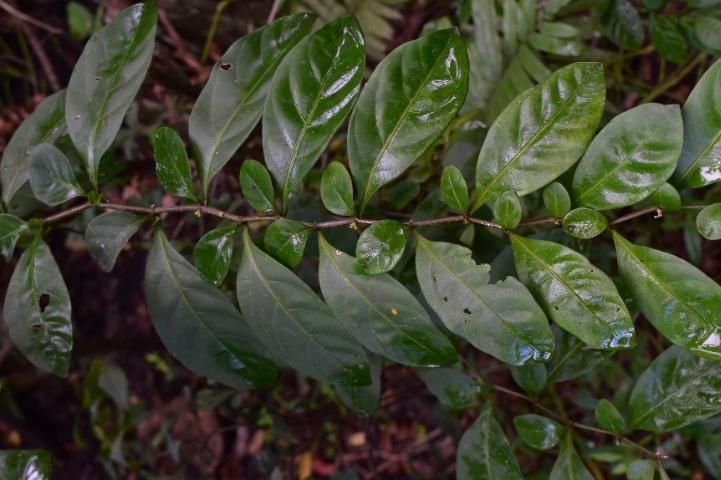
Credit: Stephen H. Brown, UF/IFAS
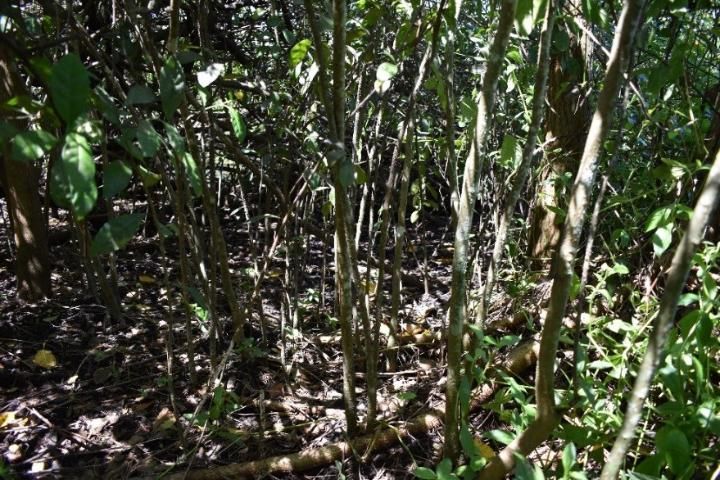
Credit: Stephen H. Brown, UF/IFAS
Leaves
Leaves are on nonfruiting and fruiting shoots. Those on nonfruiting shoots are mostly on the lower wood or older shoots. They are simple, entire, alternate, smooth and hairless, and oblanceolate. They are approximately 4.0–6.0 inches long and 1.5–2.5 inches wide. The petioles are winged and about 0.2 inches long (Figure 5).
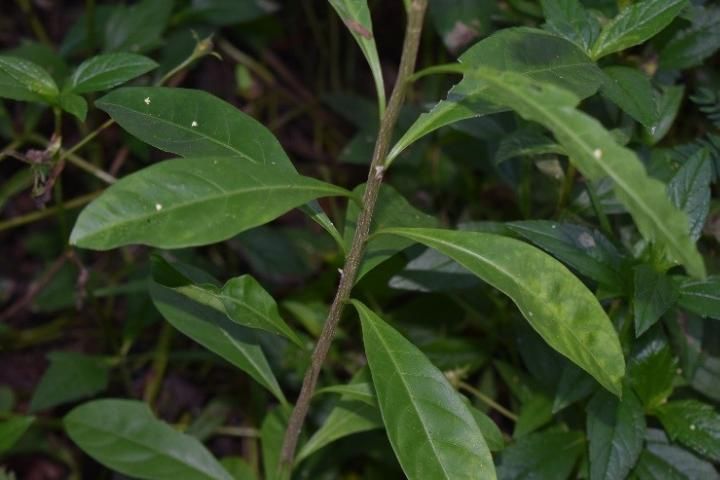
Credit: Stephen H. Brown, UF/IFAS
Leaves on the fruiting shoots are simple, entire, smooth, and hairless, with a pair of unequally sized leaves on the same node. The larger leaves are entire, elliptic to oblong, sometimes broad, widest at the center, and mostly between 3.0 to 4.5 inches long and 1.5 to 2.5 inches wide. The petioles are winged and approximately 0.50 inches long. The smaller leaves are subsessile; the blade more rounded; ovate to obovate; entire; and about 1.5 to 2.0 inches long and 0.75 to 1.0 inches wide. Some very few nodes may have three leaves on a single node, each of significantly different size (Figure 6).
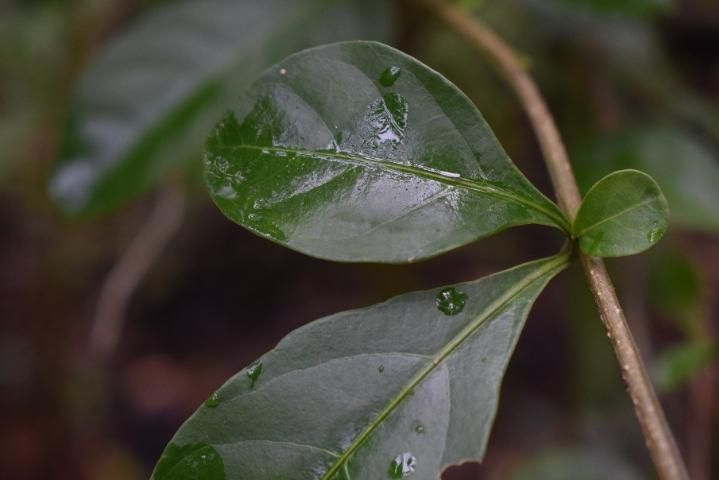
Credit: Stephen H. Brown, UF/IFAS
Inflorescences and Flowers
Most plants flower from late spring through early fall. Young unbranched plants begin flowering at about 24 inches tall and initiate branching at the same time. Inflorescences are at the nodes of fruiting shoots and arranged on short, congested helicoid cymes. The newly emerged cymes typically contain about 20 drooping flowers.
The flowers are self-compatible but are not ready for pollination until they fully expand and become erect. The pedicels at that time are about 0.2 to 0.47 inches long and approximately 0.05 inches wide (Figure 7). Flowers have five recurved petals that are white when immature to whitish-lavender when reaching maturity. The corollas are 0.14 to 0.18 inches across. There are five sepals roughly 0.10 inches long, with minute fringe of hairs on the margins. The calyxes provide a base for the fruits, securing them to the pedicels.

Credit: Stephen H. Brown, UF/IFAS
As the inflorescence elongates, becoming about 1 inch long, fewer flowers remain, and both flowers and fruit appear simultaneously on the cyme. Scars are left on the old cyme where the pedicels detached. This causes the cymes to resemble small scorpions (Figure 8). Eventually no flowers but several fruit remain on the depleted cymes (Figure 9).
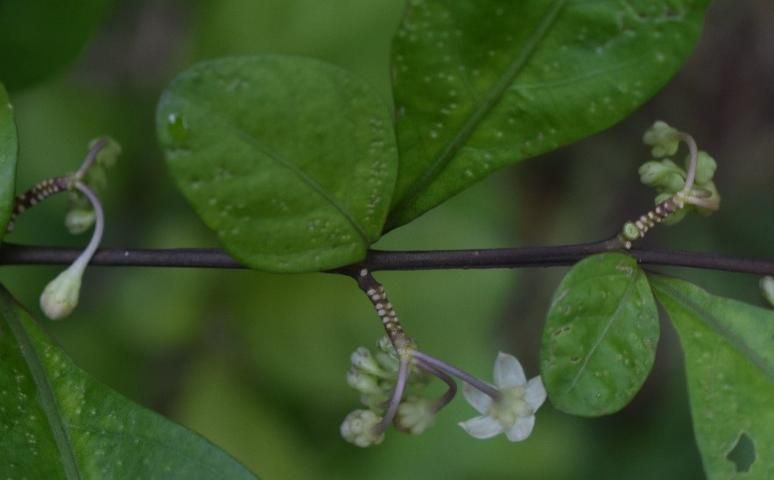
Credit: Stephen H. Brown, UF/IFAS
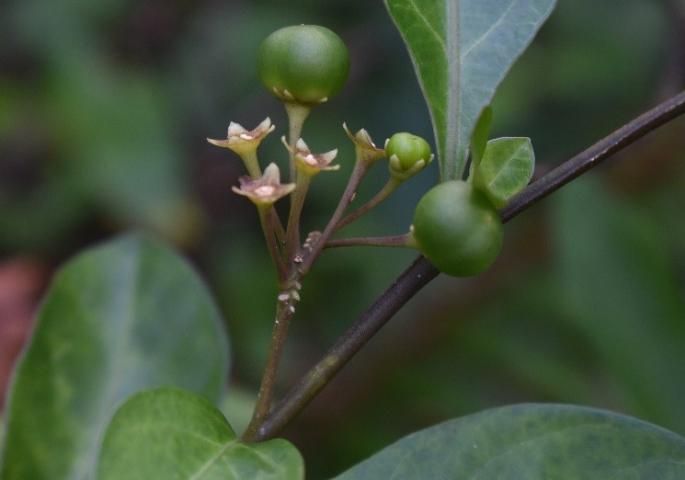
Credit: Stephen H. Brown, UF/IFAS
Fruit and Seeds
The plants produce abundant fruits. Flowers, immature fruit, and mature fruit appear on the same fruiting stem. The fruit are globose berries on top of erect woody pedicels extending to about 0.47 inches tall (Figures 9 and 10). They are slightly bilobed, especially when young. Immature fruit are green and hard, becoming bright orange and soft when ripe, and are about 0.43 inches in diameter (Figures 11 and 12). The seeds are pale yellow or tan and are a flat kidney shape, 0.12 by 0.079 inches (Figure 13). The surfaces of the seeds are minutely pitted.

Credit: Stephen H. Brown, UF/IFAS
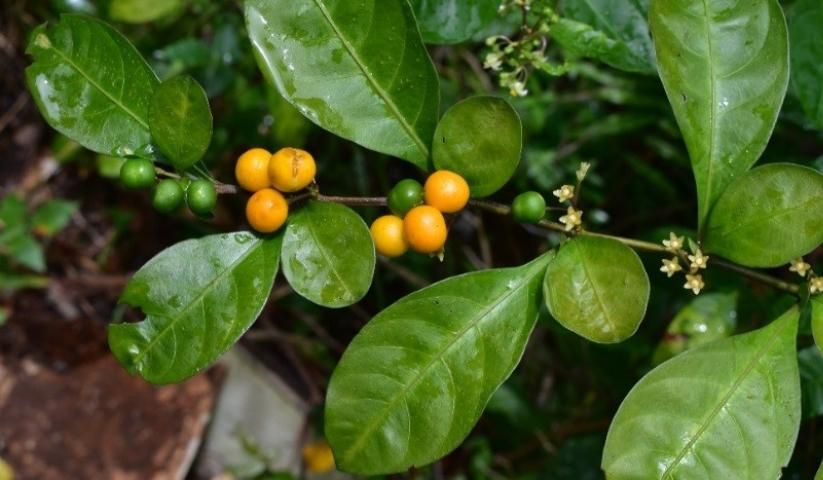
Credit: Stephen H. Brown, UF/IFAS
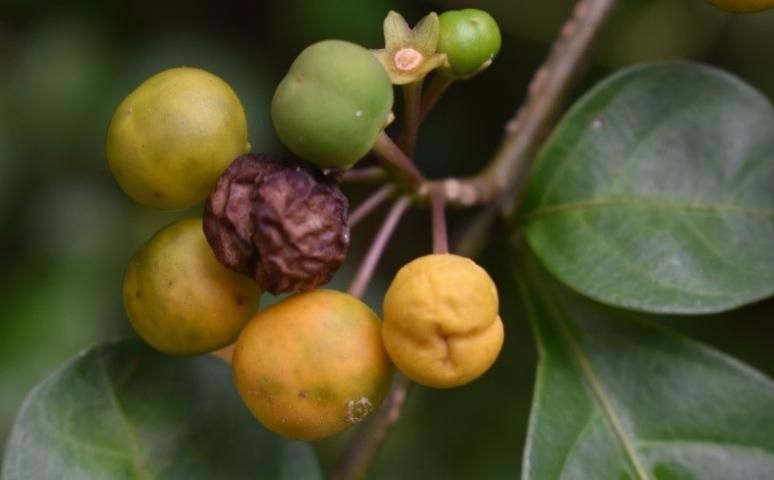
Credit: Stephen H. Brown, UF/IFAS
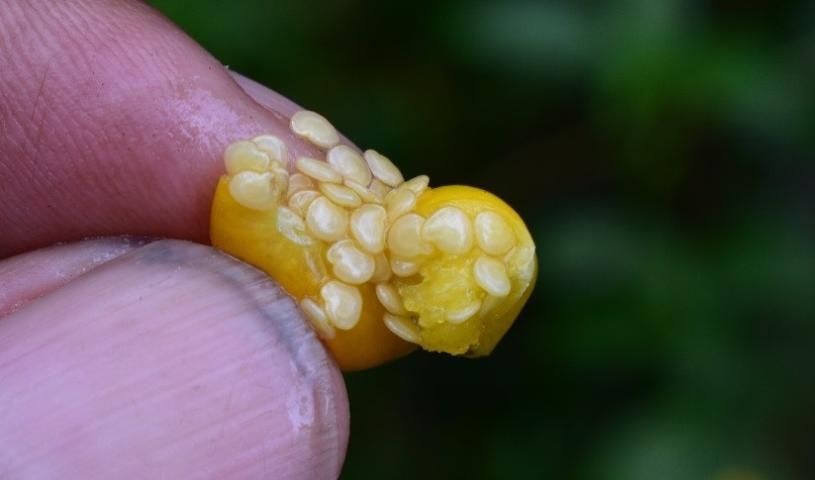
Credit: Stephen H. Brown, UF/IFAS
Toxicity
Species within the Solanaceae often have toxicity issues. Solanum plant species generally contain glycosides. The effects of glycosides on the human body are mostly dose-related and can include anorexia, nausea, and vomiting. Use caution when handling this plant. The fruits should not be eaten.
Management
Landscape (Ornamental Planting Beds)
The most effective means of control is to prevent fruit production. In landscapes, this can usually be accomplished by hand-pulling small plants out by the roots or spading out older ones from the soil. Applying 2 to 4 inches of mulch can suppress emergence of most weedy plants, especially those spreading via seed, such as two-leaf nightshade. When selecting a mulch for the purposes of weed control, choose products that are coarse-textured and will dry quickly following rainfall or irrigation.
No research has been conducted on chemical control methods for two-leaf nightshade in the landscape, but most Solanum spp. can be controlled with systemic herbicides, including glyphosate, 2,4-D, triclopyr, or aminopyralid. However, of these options, glyphosate would be the only herbicide labeled for use in landscape planting beds around ornamental plants. Because glyphosate has no soil residual activity, follow-up applications may be needed to control young plants emerging from seed.
No preemergence efficacy data exists for two-leaf nightshade, but herbicides including flumioxazin (Broadstar®/SureGuard®), dimethenamid-P (Tower® and as a component of FreeHand®), isoxaben (Gallery® and as a component of Snapshot® and Gemini®), and indaziflam (Specticle®) are labeled for control of other Solanum spp., including black nightshade (S. nigrum) and hairy nightshade (S. sarrachoides). The efficacy of these products on two-leaf nightshade is unknown, but all of these herbicides are labeled for use in planting beds for control of many problematic weed species.
Note that herbicides labeled for use in pastures, natural areas, noncrop areas of farms, or other areas should not be used in the landscape unless landscaped areas are an approved use site on the label. Many of these herbicides, such as aminopyralid, can injure nearby trees or ornamental shrubs through root uptake.
References
Florida Exotic Pest Plant Council (FLEPPC). 2019. "Invasive Species Plant List." http://bugwoodcloud.org/CDN/fleppc/plantlists/2019/2019_Plant_List_ABSOLUTE_FINAL.pdf
Knapp, S. 2008. "Typification of Solanum (Solanaceae) Species Described by Martin de Sesse y Lacasta and Jose Mariano Mocino." Anales del Jardin Botanico de Madrid 65 (1): 7–23. http://www.rjb.csic.es/jardinbotanico/ficheros/documentos/pdf/anales/2008/Anales_65(1)_7-23_2008_Solanum.pdf
Langeland, K. A., H. M. McCormick, and K. A. Craddock. 2008. Identification and Biology of Nonnative Plants in Florida's Natural Areas. SP 257. Gainesville: University of Florida Institute of Food and Agricultural Sciences.
Markle, L. T., W. A. Overholt, and K. A. Langeland. 2014. Natural Area Weeds: Invasive Solanum spp. in Florida. SS AGR 312. Gainesville: University of Florida Institute of Food and Agricultural Sciences. https://edis.ifas.ufl.edu/ag318.
Perkins, K. D., and W. W. Payne. 1978. Guide to the Poisonous and Irritant Plants of Florida. Circular 441. Gainesville: University of Florida Institute of Food and Agricultural Sciences. https://ufdc.ufl.edu/UF00000155/00001.
Knapp, S. 2013. "Solanum diphyllum." Solanaceae Source: A Global Taxonomic Resource for the Nightshade Family. http://solanaceaesource.org/content/solanum-diphyllum.
"Solanum diphyllum." 2019. UF/IFAS Assessment of Non-Native Plants. https://assessment.ifas.ufl.edu/assessments/solanum-diphyllum/.
"Solanum diphyllum." n.d. Flora of China 17:317. http://www.efloras.org/florataxon.aspx?flora_id=2&taxon_id=200020581.